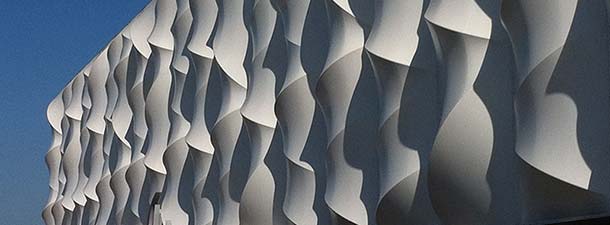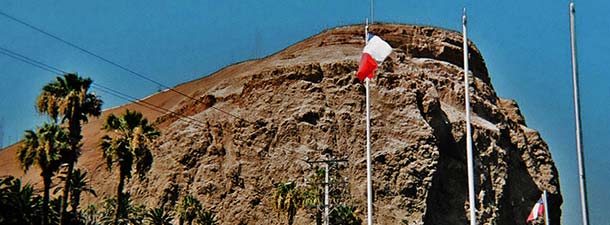
21st Century Design – Rediscovering the Wisdom of the Past
August 1, 2013
Is Corporate Social Responsibility Anti-State? A Programme
August 1, 2013Arica, Chile, situated in one of By Mike Hawthorne the most desolate climates in the world, has always been a city on the edge – far from the centres of power, clinging on in a hostile environment, sometimes maintaining the merest veil of civilisation – if that. As our society slouches relentlessly towards a future of resource-based conflict, Arica may be a taste of what is to come for many of us. Can it also show us a way to manage that future?
The Chilean port of Arica (population just under 200,000) sits on the Pacific rim of the Atacama Desert. Known as ‘The City of Eternal Spring’, it enjoys an average temperature of 19 degrees Celsius all year round. The windswept ridges of the driest wasteland in the world plunge abruptly into the cold ocean current to the south. Barely visible on the eastern horizon, the high snowy peaks of the Andes advance into Bolivia. A long bay curves north from the town towards the nearby border with Peru. Arica, the old coastal depot for the fabulous Potosí silver mines, was once deep inside Peru, and, before that, part of the Inca Empire. Over ten thousand years ago, the ancient Chinchorro civilisation fished, traded with inland tribes and mummified its dead in Arica’s valleys. Hundreds of masked Chinchorro skeletons, preserved in family groups, appear beneath the foundations of new buildings so often that construction companies are tempted to avoid delays by quickly concreting over the oldest mummies in the world.
On either side of Arica’s twin rivers, the Atacama seems as inhospitable as the surface of Mars, scorching by day and bitterly cold at night. Naked rock formations provide ideal testing grounds for interplanetary robot vehicles. No urban light pollution blurs the dazzling constellations. Observatories aim huge telescopes at the sky, gathering increasingly astonishing images and information about the size and scale of the cosmos. Between high mountains, vast deserts, an immense ocean, with a clear view of Earth’s tiny place in the heavens, Arica feels like a little oasis on the very edge of creation.
The entire extent of Chile lies on a tectonic fault which is driving the seabed under the continental shelf. The Andes are being squashed upwards. The whole country is under tremendous strain, periodically releasing accumulated tension in shuddering jerks. A deep, mega-thrust earthquake obliterated Arica in 1868, followed by a tsunami that dumped ocean-going liners on top of the ruins. An event of similar magnitude is expected again at any time. Signposts with arrows point to stairways and escape routes, leading to higher ground inland. Arica survives on the edge in more than one sense.
The port’s twin rivers flow from the Andes to the coast in parallel courses. The northern Rio Lluta is salty – good for irrigating staple crops like maize, alfalfa and onions. The southern Rio Azapa, which dries up in the summer, brings sweet water into a lush tropical valley. Malaria used to be endemic, but is now under control. Fruit orchards flourish, beside big, juicy olives and tomatoes. With abundant fish stocks nearby, nature has provided the ideal balanced diet. Inventive, spicy Peruvian sauces enliven Chile’s cruder cuisine. However, the two countries have reversed their status since the imperial days of the Incas and Spaniards, when Chile was still a penal colony on a brutal southern frontier.
Now, impoverished Peruvians migrate south to work in Chile as labourers and domestic servants. Many speak with a more refined Spanish accent than their new employers. They regard the Chileans as predatory upstarts who attacked their neighbours in Bolivia and Peru to seize the Atacama’s nitrate deposits on behalf of greedy British bankers and mine bosses in the nineteenth century. Some Chileans respond by giving themselves racist airs, harking back to the imagined genetic superiority of warlike Mapuches mixed with ‘Visigoth’ conquistadores over their darker, ‘cholo’ neighbours. During the War of the Pacific (1879-1883), Arica was taken from Peru during a savIssue 05 August-September 2013 | DANTEmag 53 age campaign on land and sea. Bolivia lost its coast to Chile too. A hundred and thirty years later, the war still rankles. Peru tries to extend its fishing rights into Arica’s waters. Bolivia demands a ribbon of land giving access to the sea. Chile reminds them both of its military strength and its support from the US. Politicians in all three countries use the continuing border disputes to stir up nationalist sentiment. On all sides, flag-waving confrontations distract the public from internal problems and deliver more votes than does international cooperation. Meanwhile, US, Canadian, Chinese, Australian and European corporations compete to plunder the region’s natural resources. Environmental legislation is seen primarily as a tool to extract a little more tax revenue from these foreign enterprises. The actual condition of the environment is secondary, especially for Chilean President Sebastian Piñera’s businessman’s government, which tends to privatise and sell everything to the highest bidder.
Does environmental damage matter in a desert? What is there to destroy? Around Arica, it matters – especially if the precious river valleys are threatened. Here environmental issues can combine with border disputes to deadly effect. Much of the Rio Azapa’s flow originates in Andean meltwater on the Bolivian side. Global warming and the Bolivians’ diversion of this water into their own desiccated highlands could leave Arica very thirsty indeed. Paradoxically, increasing drought causes sudden flash floods, during the so-called ‘Bolivian Winter’ in the mountains. The torrent picks up raw sewage, topsoil, plastic bags, animals and, occasionally, land mines planted by Pinochet’s soldiers. Bathers are warned to stay off the beaches at such times. At worst, as the global population continues to expand, history will degenerate into battles over water, even in this corner of the world. Unless human nature changes, the basis of life itself, the main component in every living body, will become a luxury item worth killing for.
To decrease dependence on Bolivian sources, Arica’s plans include the wildly expensive possibility of a desalination plant and a maritime pipeline bringing fresh water from Chile’s rainy south. Meanwhile, the population suffers from chronic kidney disease due to toxins in the local supply. The Estrella de Arica newspaper asks, “Are We Being Poisoned?” The answer, very often, is yes. Currently, magnesium mines planned by an Australian multinational threaten to leak poisons like arsenic into the Azapa and the water table beneath the National Park near Putre. Pollution from mines in the uninhabited desert can be ignored more readily, but in the valley, it directly menaces agriculture and public health.
In Chile, while the soldiers may have stepped back into the shadows, the economy is still run on Milton Friedman’s ‘Chicago Boy’ principles inherited from the dictatorship. The public health system in Arica lies in ruins. General practitioners are in short supply. However, cheap treatment is available just across the Peruvian border. Crowds of notionally ‘more developed’ Chileans find themselves queuing at the frontier to visit Tacna’s hospitals and clinics. During their stay, they also take advantage of lower prices for electric goods and sportswear, manufactured by Peru’s sweat shops for international brands like Lacoste. Transporting people to and fro is an industry in itself. Fleets of taxis and buses raise clouds of dust on the Arica-Tacna highway every day.
Naturally, smuggling is a lucrative activity, with cocaine at the top of the chain. Connected gangsters can breach border security with hidden cargos. Dogs sniff at rucksacks in the terminals, but one cannot search every vehicle. Meanwhile, the enormous ocean to the west is impossible to patrol effectively. A single consignment of narcotics is worth thousands of nocturnal fishing trips. In the desert to the east, impoverished ‘mules’ sometimes bury themselves under the scorching sand by day, to emerge and continue their desperate journeys under the stars. Some have been found frozen to death, or killed by thirst, after wandering deliriously around in circles, dropping their precious bags of white powder into the dunes. Their bodies can remain undiscovered for hundreds of years, since it is too dry for vultures in this merciless landscape. Recently, the Latin American nations have come out in favour of drug decriminalisation. However, while US government policy continues to dominate the drug agenda, sustain the criminal trade, construct private prisons-for-profit and use the police to harass the poor, there is little hope for significant improvement. Arica is a key staging post. A few grams of cocaine from Peru’s jungle laboratories suddenly skyrocket in value a couple of kilometres to the south. By the time they vanish up some Citigroup banker’s nostrils in Santiago de Chile, 1,300 miles further down the Pan-American Highway, fortunes have been made.
Although adultery, usually in one of the many discreet motels, is the unofficial national sport, Chile is outwardly prudish. Divorce was only legalised in 2004. Topless bathing remains a punishable offence. Generally, Chilean women do not resort to prostitution easily. This makes Arica’s relatively open attitude to sex unusual in this country. Dildos and other toys are openly displayed in shop windows. They even sell a green vibrator shaped like a cactus, ideal for desert dwellers. The prostitutes are brought in from Colombia, Bolivia and Peru. Some are victims of organised trafficking linked to the cocaine trade. Pathetic notes thrown from locked apartments have alerted passers-by to the presence of captive women being held as sex slaves. Cheaper male transvestites, with breast implants made from industrial Peruvian silicone, are popular with off-duty privates from the numerous Chilean garrison regiments. However, the main action has moved south to Iquique, which has replaced Arica as a tax-free port, and services the well-paid, lonely and frustrated copper miners. While Iquique rises, Arica declines. However, incredibly for Chile, the Arica area continues to offer live sex shows among the casinos and drinking establishments. It is the gateway to a large market of all-male workforces, far from home, eager to blow their wages by getting out of their heads in every conceivable way.
Recently, the army has called up a draft of 57,000 18-year-old conscripts, blaming the ongoing student protests against privatised education for the lack of volunteers. Activists see this as another example of a policy that deliberately dumbs down half the population while recruiting for its historic oppressors. Since the government of Ecuador ejected its army, the USA has been strengthening its grip on Chile. Another version of the Escuela de Las Americas, Panama’s infamous old CIA torture academy, has opened in Concón, near Valparaiso. US ‘advisors’ frequently visit the northern desert, which is ideal terrain for testing new weapons for the Middle East. Israel, one of the first countries to applaud the 1973 coup, has infiltrated parts of Patagonia. Now Israeli reconnaissance units, with Chilean military approval, are scouting in the Atacama too. Having invented the ‘War on Terror’, alongside the ‘War on Drugs’, the US is keen to keep Chile firmly within its empire. Visa restrictions have been lifted. In Arica, special housing developments for military families occupy prime real estate. The Armed Forces offer secure pensions, technical training and right-wing indoctrination in return for blind obedience. For the struggling poor, it is a tempting offer.
The situation is aggravated by the high import duty on books, including educational textbooks. There are only two small, poorly stocked bookshops in the entire town of Arica, and you have to search for them. An underpaid, ill and uneducated population is hardly likely to worry about the environment. A short-term, ‘get-rich-or-die-trying’ mentality is more probable, feeding the drug trade and its associated gangster culture. The Old Left, crushed to pieces by years of dictatorship, has not been able to slow down the triumphant Free Marketeers. The media over-report robberies, the security industry cashes in. Often, the same owners manage both the media outlets and the security firms. The winners hide in gated communities, sprinkling water on their golf courses. The drones swallow anti-depressants in their noisy, graffiti-covered, concrete hives. The losers fry under corrugated iron, choking on dust in dry riverbeds. The whites remain on top, the Indians below. God is in His heaven. The Wild West ethos of the conquistadores and US robber barons is still the main show in town.
Just over the horizon, Evo Morales, Bolivia’s Indian president, makes the right noises in his United Nations speeches: “Not only do human beings have rights, but Mother Earth should have them too. The capitalist system has made the earth belong to human beings. Now, it is time to recognise that we belong to the earth.”
Unfortunately, in Chile, Morales is demonised and ridiculed. Chilean capitalists cannot stomach the thought of large fossil fuel deposits in socialist Indian hands. They pray for a destabilising secessionist rebellion in Bolivia’s Santa Cruz area, an enclave of wealthy, white, neo-nazi hotheads on the other side of the mountains. At present, Chile imports frozen liquid gas in tankers, while Bolivia still possesses major deposits, despite centuries of ruthless exploitation. For the corporations, it is still the old game of threats, bribes and empty promises, with an eye on the Wall Street index. Behind the Bolivia’s Ministry of Environment and Water says, “How are you going to tell someone struggling to feed their family that they can’t cut down a tree, dump garbage, or irrigate their crops with dirty water?” More to the point, how can you resist the buying power of corporate shareholders?
In the Atacama, there are little pockets of hippies and messianic cults, posing in their ponchos, imbibing hallucinogenic hayahuasca and sucking on spliffs, but they tend to be bored children of the rich going through a rebellious phase. You are more likely to find a David Koresh, or Charlie Manson, than a Che Guevara among that lot. ‘Ecotourism’ is the new catchword. Cycling and trekking up the valleys towards the lakeside volcanoes, eating with humble families, and visiting with shamans are advertised as alternatives to those picnics in the four-wheel drive with nature as nothing more than a pretty backdrop. But here, in declining places like Arica, the old indigenous ideals of ‘stepping lightly on the earth’, in balance with Nature, could still resurface as more than a catch-phrase, while Iquique becomes a sterile urban hell of skyscrapers, banks, brothels and casinos. That is the real desert, waiting down the road: Wall Street mixed with Las Vegas. In the long run, Arica, might escape the worst.
Nestling behind lovely beaches under an immense rock, palm-lined avenues lead into a walkable, humansized town. If Arica can recover its nerve, after the boom and bust of the tax-free days, and the years of terror under Pinochet, it might become a model environment. The ‘old town’ (virtually nothing survived the 1868 earthquake) contains decaying Victorian houses that could be transformed into gems. The owners of the ‘Asi Sea’ bar, near the cathedral, have shown how this can be done. In the valleys, the ancient sites are slowly being preserved and displayed to advantage. On a street leading up to the spectacular cliff of the Morro stronghold, the University of Tarapaca has constructed an airy space over a transparent floor, under which dozens of mummified skeletons are visible. Scientists are researching rare seeds for future crops in the salty Lluta valley. The whole area is stunningly, dramatically beautiful. It is waiting to shake off its depression and tackle the future with imagination and respect for nature. That is Arica’s real edge.




